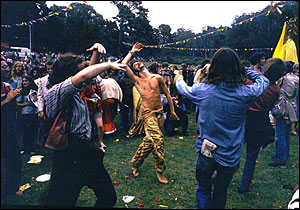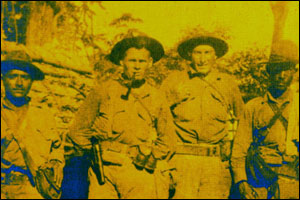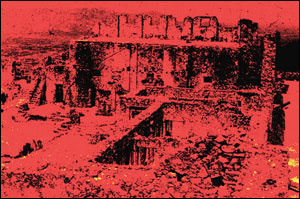Projects
When DXY passed away in 2001, he had numerous projects in the works.
JAZZLOFT

From 1954 to 1964 David X Young held open door jam sessions in his painter’s loft at 821 Sixth Avenue in the flower district of Manhattan.
Some photographs of these sessions by his neighbor W. Eugene Smith were shown in two television segments on both CNN (Feb 20, 2000) and CBS SUNDAY MORNING (fall 2000) with interviews of Young and some of the musicians who played there. A book of DXY’s own photos and paintings from those days, including 2 CDs of sessions recorded by Young, plus a poster of his painting ROLLINS SHAMAN are in “DAVID X YOUNG’S JAZZLOFT”

Looking back historically it was a big event– at the time all we wanted to do was play. and it was courtesy of Dave that the whole thing happened and kept happening. He was the man who taped us, who made the whole thing happen and it was our respect for him, his flagrant love for us and our music and, in turn, our high regard for him as an artist that created this incredible environment in which we flourished, continuing a very unusual and important period in our music.
Bob Brookmeyer

What Gertrude Stein’s Paris salon was to writers, the loft in New York City was to jazz musicians. In fact, for a brief moment, the loft may have been the center of the jazz universe — a bastion of experimentation and improvisation. A little place where legends jammed and where solos lasted till dawn.
Jeff Greenfield, CNN & TIME, broadcast Feb 20, 2000
HAITI
DXY had numerous project concepts related to Haiti.

- Hip Haiti — Book proposal with photographs
- Haitian Energy Field — Collection for exhibit
- Seven Haitian Moods — Short film
- Rwa Congo — Feature screenplay
- The Unexpected Zombi — Feature screenplay
- Christophe King — Feature screenplay (unfinished)
FILMS
KLAXIMO
1963, 27 minutes
The last day of shooting on this film was done the day JFK was shot in Dallas. Called by some an “industrial erotic”, at the time of filming it was done in protest against the conceit that technology and the artificial will someday replace the centrality of the human. The most intimate of human acts, the sexual, is shown to have a mechanical counterpart. The film is very erotic but not a whit pornographic; it is all conjured illusion. Incidental music by Carsten Bohn, title song by Young and a closing theme by Zoot Sims. KLAXIMO was intended to make a shock-awareness of the dangers of the intrusion of the mechanical in our life, somewhat in the spirit of Bunuel. At the time of its making, the Warhol crowd was attempting to take over vanguard experimental film, and for inexplicable reasons this gay contingent hated the film violently, and went to great lengths to prevent its ever being shown. Thus, inadvertently, it became “The Film That Shocked The Avant Garde” and has only rarely been shown to the public.

ROOTS OF THE COLD WAR
1968, 28 minutes
What it took CNN 24 hours to do is here told with great brevity and clarity. Made with the cooperation of historian Arthur Schlesinger, Jr. in 1968, this film sold regularly to universities until the actions of Gorbachev more or less destroyed the Cold War twenty years later. This particular version is set against the furor of the sixties and the Vietnam war.

SEVEN HAITIAN MOODS
1986, 33 minutes
Filmed over a forty-year period in Haiti, with the idea that the only way to really understand Haiti is to be physically there. Life in a peasant village by a stream is shown without comment. The last great Carnival of 1956 is shot with a sense of actual participation, plus many glimpses of Haiti prior to 1986. Rare footage of Duvalier’s first palace reception opens the film, which climaxes with a sense of revolutionary pride.

INCONVENIENCES
1998, 120 minutes
Edited in the manner of most television biographies, this is Young’s family history to date, a “curriculum vitae” of a very erratic and productive life. There are many hairy moments, and despite its length it is not without humor and is not at all boring. You get to see a lot of art along the way. A portrait of a life and a time.
FEATURE SCREENPLAYS, UNPRODUCED

THE DUCK SEASON
129pp
Covers a period from the end of October to New Year’s Day of two barely fictional Cape Cod towns. Essentially it follows the conventions of an old fashioned horror story wherein, at the climax, the townspeople grab their torches and rush to burn the monster in his castle. In those tales the monsters were the “round” characters and the good scientist and his wife plus townfolk were “flat”. Here the round characters are flattened somewhat and the flat ones rounded, to make it more like real life, and the motivations are made more logical. From this a lifelike true horror emerges, while retaining the classic atmosphere.

RWA CONGO
139pp
During the U.S. Occupation of Haiti 1915-1934, most of the then Marines were white racists with very few exceptions. One of these Marines, curiously named Faustin Wirkus, harbored no prejudice but instead held a fascination for the culture of Haiti as best as he could understand it, and when the opportunity arose, became the sole Marine power on the elusive Isle de La Gonave off the coast of Haiti. There, against Marine regulations, he allowed vodun to be practiced and the communal Congo societies to flourish, encouraging them through his office with good grain, stud pigs, and a means to transport their product to the mainland. In gratitude, the Congos persuaded him that he was the reincarnation of an earlier Haitian king, Faustin Solouque, and crowned him “King” of the Congo Societies and also La Gonave itself. This true adventure story has strong elements of fantasy built into it, and because of this is told as straightforwardly as possible. Yet it remains an enchanting tale, as well as one of the best examples of American aid in U.S. history.

THE UNEXPECTED ZOMBI
105pp
Essentially, Michael Milliken goes to Haiti. A high finance type of sexual sluggishness, in love with a nun breaking her vows to discover herself as a woman, vacation in this ragtag caribbean country full of magic tradition to find their imaginations awkwardly engaged. Protagonist’s imagination is contaminated by too much television, and when confronted by events germane to Haiti but difficult to rationally explain, goes quite off the wall. Ex-nun is thrown back upon her compassionate vows to extricate herself. This fictional vodun thriller is partly based on folk tales of the island as well as certain true events.

CHRISTOPHE KING
(unfinished)
An approach to condense the incandescent majesty of the Haitian Revolution, its many contradictions and mythic proportions into one feature length experience, to include its three great leaders Toussaint, Dessalines and Christophe in their very separate and distinct personalities, to illuminate one of the most dynamic and vibrant periods of our hemisphere’s history; the first slave revolt since Spartacus.
Currently, the Estate is working to organize these projects as well as new ones. If you are interested in any other these projects or would like to propose one that relates to DXY, please contact the Estate.



